|
|
Post by Reptisaurus! on Jun 11, 2019 17:35:41 GMT -5
Holy crap, David Mazzucchelli is good.
|
|
|
|
Post by profh0011 on Jun 11, 2019 19:01:41 GMT -5
The MARVEL PREMIERE reprints probably led me to buying issues of DOCTOR WHO WEEKLY and then DOCTOR WHO MONTHLY which was eventually renamed DOCTOR WHO MAGAZINE.
When I first saw these, I remember thinking they were probably the BEST adaptations of any TV show I had ever seen in a comic-book. The writing and the art were both excellent, and Dave Gibbons also did VERY good likenesses of the lead actor.
Over quite a few years that followed, I saw MANY different artists tackle DOCTOR WHO, both in the new magazines as they came out, and reprint collections of earlier strips from the 60s & 70s. Of all of them, Dave Gibbons REMAINS my favorite DOCTOR WHO comics artist by a very wide margin, with the only other artist who comes to mind being John Ridgeway, who illustrated Colin Baker stories.
It was probably Dave Gibbons' art that attracted me to buying his run of GREEN LANTERN, a book I stuck with for far too many years after he left, though both good runs and HORRIBLY BAD, UNREADABLE runs.
I recall many years later following GREEN LANTERN CORPS for awhile, and every time Gibbons would do a fill-in issue, the level of visual storytelling IMPROVED 100-fold over the more "flashy" artists who were that series regulars.
In fact, the only downside to Gibbons' career that I can recall, was when would do writing-- without doing art-- on WORLD'S FINEST. That mini had my #1 favorite comics artist on it, Steve Rude... and despite those 2 talented people involved, I found the stories close to unreadable-- in fact, bordering on INCOHERENT. I believe Gibbons later wrote GLC, which was at least coherent and readable... but when he'd step into the art side as well, the stories improved more than I can begin to describe.
|
|
|
|
Post by codystarbuck on Jun 11, 2019 19:10:01 GMT -5
I have no problem with Worlds Finest; enjoyed it then, still enjoy it now. Different strokes, and all that.
It's funny, as the first MP letters column after the 1st Doctor Who reprint is singing Gibbons' praises and asks when they are going to get him over to the States. They talk about "Just wait." Yeah, well,, he came....to the Distinguished Competition!
It's interesting that Marvel had the UK branch, yet DC was the one who benefitted from an influx of UK talent. Bad blood with Marvel editorial or just DC making a better offer? Or perhaps the benefit of Len Wein coming over to DC?
|
|
|
|
Post by badwolf on Jun 11, 2019 20:40:12 GMT -5
Over quite a few years that followed, I saw MANY different artists tackle DOCTOR WHO, both in the new magazines as they came out, and reprint collections of earlier strips from the 60s & 70s. Of all of them, Dave Gibbons REMAINS my favorite DOCTOR WHO comics artist by a very wide margin, with the only other artist who comes to mind being John Ridgeway, who illustrated Colin Baker stories. Ridgway was my favorite on DW. Have you seen Richard Piers Rayner's recent work? Like Ridgway he comes closest to making the characters look just like the actors. |
|
|
|
Post by codystarbuck on Jun 12, 2019 12:18:53 GMT -5
You do have to remember that the issue of making characters look like the actors is a complicated one. Actors usually have control over the use of their likeness (the Star Wars cast signed away most of that, in use with the franchise) and in many cases the use of an exact likeness has not been authorized. So, the artist is stuck with trying to make it look close enough to the actor for audience identification; but, not so close as to get sued for unauthorized use.
Licensed comics come with built in headaches, as the licensor has say on the use, usually, and some are more picky than others. Topps had nightmares with Chris Carter and the actors, over the X-Files comics, which led to huge delays in putting out issues, as they would delay the approval process. Marvel had problems with some plots, because they were too close to what Lucas was doing, but Lucas wouldn't clue them in to keep his little secrets. Peter David had massive issues with one person at Paramount, which made Star Trek problematic, until that person was replaced.
Being able to put out a great story, with a licensed property, is often quite a triumph.
|
|
|
|
Post by chaykinstevens on Jun 12, 2019 14:37:20 GMT -5
Marvel Premiere #57Creative Team: Pat Mills & John Wagner-writers, Dave Gibbons-art, Andy Yanchus-colors, Dez Skinn-original editor. Although Mills and Wagner were credited as co-writers, they actually worked alone on alternating stories. This one was by Mills, and the story in Marvel Premiere #59-60 was by Wagner. |
|
|
|
Post by earl on Jun 18, 2019 18:45:00 GMT -5
That costume in the X-men story is one of many in old Marvel's that seems very influenced by Zardoz (starring Sean Connery). Pretty hilarious in hindsight.
|
|
|
|
Post by earl on Jun 18, 2019 18:45:41 GMT -5
That Dave Gibbon's page from Dr. Who with the zeppelin is amazing.
|
|
|
|
Post by zaku on Jun 19, 2019 6:19:25 GMT -5
The Storm story is a continuity piece, to show how Storm got info that helped her find Rogue and lose her powers, thanks to Forge's weapon. It also implies that Mystique and Destiny are lovers, which was kind of there before. The club they meet in seems like some weird S&M disco, or something. Complete with people who look like this...  I wonder about Claremont, sometimes... Anyway, pretty decent issue. These later ones are vast improvements over the early stuff, though they are hardly classics. Just nice, entertaining little diversions. Sometimes I wonder why Claremont never did a straight-BDSM story, after Marvel had ceased to adopt the Comics Code... I mean they did it when they published a Black Widow (not-Natasha, the second one) story in the Max imprinting...  |
|
|
|
Post by codystarbuck on Jun 19, 2019 10:16:35 GMT -5
The Storm story is a continuity piece, to show how Storm got info that helped her find Rogue and lose her powers, thanks to Forge's weapon. It also implies that Mystique and Destiny are lovers, which was kind of there before. The club they meet in seems like some weird S&M disco, or something. Complete with people who look like this...  I wonder about Claremont, sometimes... Anyway, pretty decent issue. These later ones are vast improvements over the early stuff, though they are hardly classics. Just nice, entertaining little diversions. Sometimes I wonder why Claremont never did a straight-BDSM story, after Marvel had ceased to adopt the Comics Code... I mean they did it when they published a Black Widow (not-Natasha, the second one) story in the Max imprinting...  Not comfortable admitting his interests? Hey, he's not Howard Chaykin!  Too bad Eric Stanton was gone, by that point; he could have done a whole line for Marvel. |
|
|
|
Post by codystarbuck on Jun 19, 2019 14:54:44 GMT -5
Grab your jelly babies; We've got more Doctor Who. Marvel Premiere #59-60  59's cover by Gene Day, 60 had an Earl Norem cover. Kind if a rarity, for both. Day did covers for Master of Kung Fu; but, you don't see a ton of covers from him beyond that, part from inking someone else's pencils. Norem worked primarily with the Marvel magazines (when he did work for Marvel) and went way back with them, including work on Goodman's line of men's adventure magazines. Have to wonder if this cover had been intended for a Dr Who magazine. Wouldn't be surprised if Marvel had intended to try a Dr Who magazine; but nixed the idea and split the material between these 4 issues. These reprint Dr Who Weekly #9-16 (59 reprints 9-12, 60 reprints 13-16) Creative Team: John Wagner & Pat Mills alternating on stories; Dave Gibbons doing the heavy lifting on art. Carl Gafford-colors No editor credits, though Dez Skinn was the original UK editor. Jo Duffy provides some background info, on the editorial page. 59 has a Werewolf By Night story from Steven Grant & Win Mortimer . Mortimer did a lot of work for DC, after WW2, on Superman, Superboy and a lot of Batman, as well as Scooter and Stanley & His Monster. He did comics and coloring books for Western (for the Whitman line) and did Spidey Super Stories at Marvel. he also drew stories for some of the horror comics, there, and a few straight superhero comics (as opposed to the younger reader Spidey stories). Spidey Super Stories was actually far better than it had a right to be, given how that kind of thing used to be treated. Synopsis: The Doctor, who (no pun intended) needs to take that thing to a mechanic, has control issues with the TARDIS and lands on a planet, in The City, where he runs into The Tick and Arthur. Oops, scratch that, this is a different The City. That would be a cool crossover, though.... Anyway, emotion is outlawed here and everyone is a conformist zombie. Well, almost everyone. 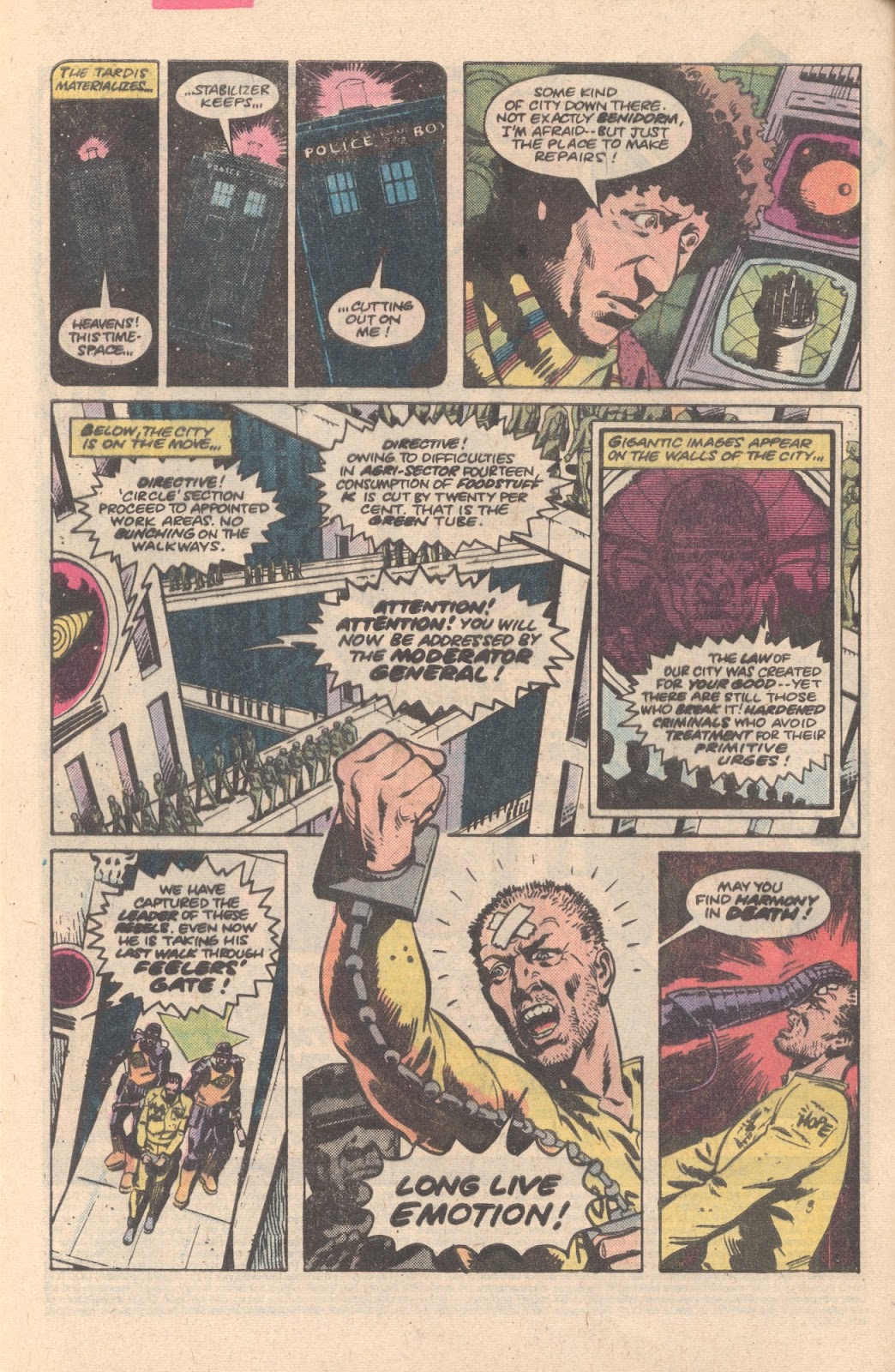 Faster than you can say "Repent, Harlequin!"the TARDIS materializes in someone's living quarters, where they are having breakfast (consisting of brown goo in a tube that brings to mind a metaphor that is to horrible to name). They are rather blase about the whole thing and turn down the offer of jelly babies. Then, A is recalled for a bad ticker and B finds that he eyes tear uo as she says goodbye. She goes into a Harmony Chamber for readjustment, which seems to involve shock therapy. The Doctor is a put put out by all of this. The Moderator General, the lord high muckety-muck of The City, sends out a Moderator Squad, who meet the Doctor and arrest him. So, business as usual. he is brought back and makes witty remarks to humorless men and learns that Zom, the planet, had been a society of crime and decay, until the Moderators took control and eliminated emotion and made everyone model citizens. As in plastic models, with no feelings or thoughts. It wasn't exactly a democratic choice, either. The Doctor is about to be subjected to treatment, when ZEPO (Zom Emotional People's Organization) attacks. They free the Doctor and flee on rather improbably wing contraptions, though the Moderators give chase. They escape outside the city and back to their base. meanwhile, the Moderator General is called before the Brain Trust, a goup of bodies with giant brains who run The City. He is ordered to destroy the Doctor. At the Zepo camp, the Doctor meets the denizens, who are each named for an emotion, which they project to keep it alive. When they retake The City, they will teach others their emotion. The Doctor sees some acting comically and laughs, a sound which none have heard. It appears to fulfill a prophesy of a deliverer, from the stars. The Doctor isn't one for godhood and is interrupted by Big Hate and the Haters (which is not a metal band, as you would think) and, then, the Moderators attacking and slaughtering the ZEPO folks. 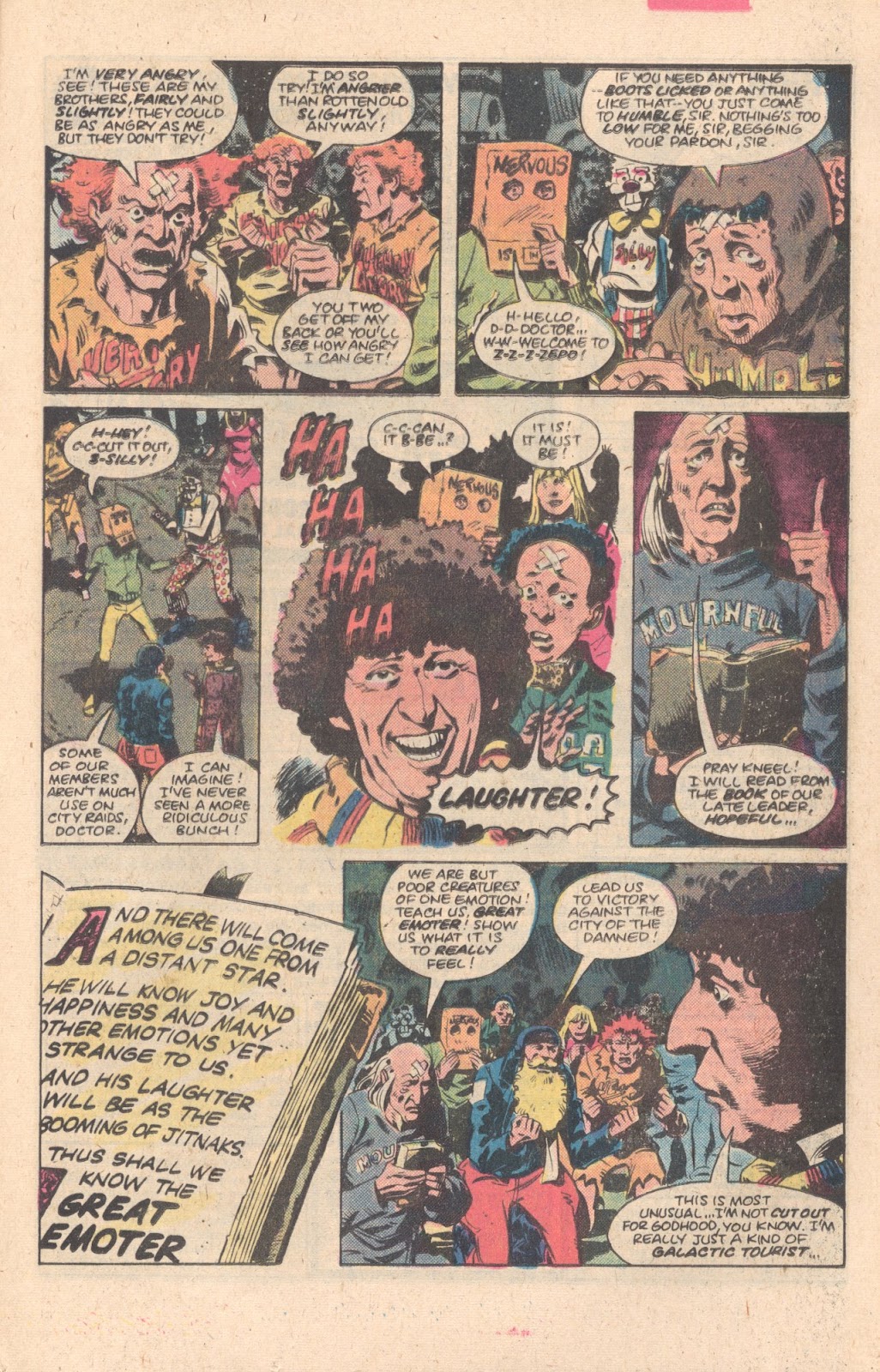 In the melee, the flesh eating bugs of Big Hate are released and engulf the Doctor, but, they die when they try to bite him. He is rescued as he makes the observation. The Moderators, on the other hand, end up bug chow. The Doctor figures out that adrenaline is the key, as the release of it, due to emotional stress, saved him, as the bugs find it to be poison. they all realize that the entire City is in danger, as Big Hate goes to release the critters on the City, where all are emotionless. They go after him to stop things. 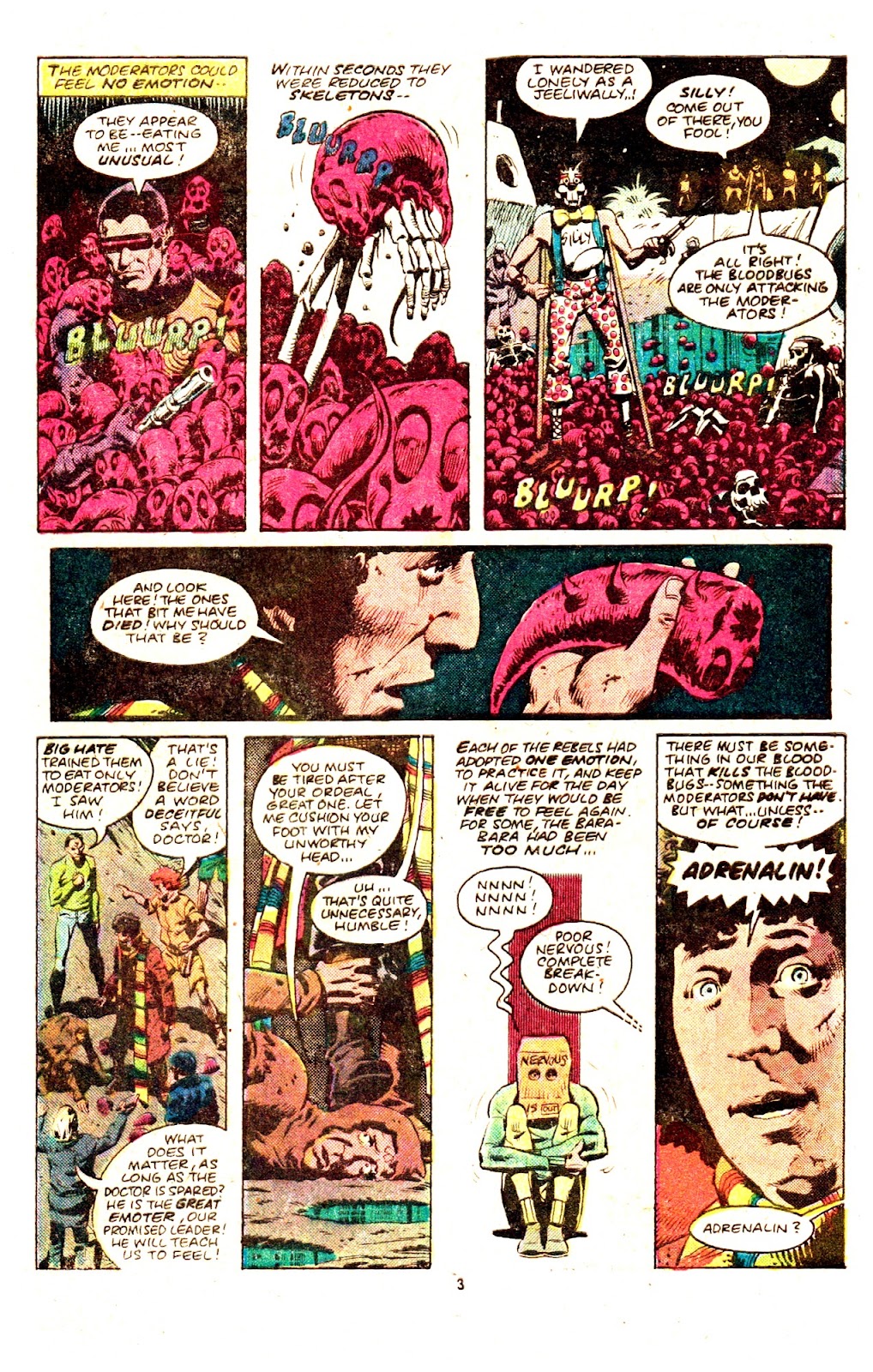 Big Hate has loaded them onto the food stuff conveyors to the City. The Doctor and ZEPO commandeer a massive harvester and chase after; but, are attacked by a Moderator tank. The crush through it and head into the City. 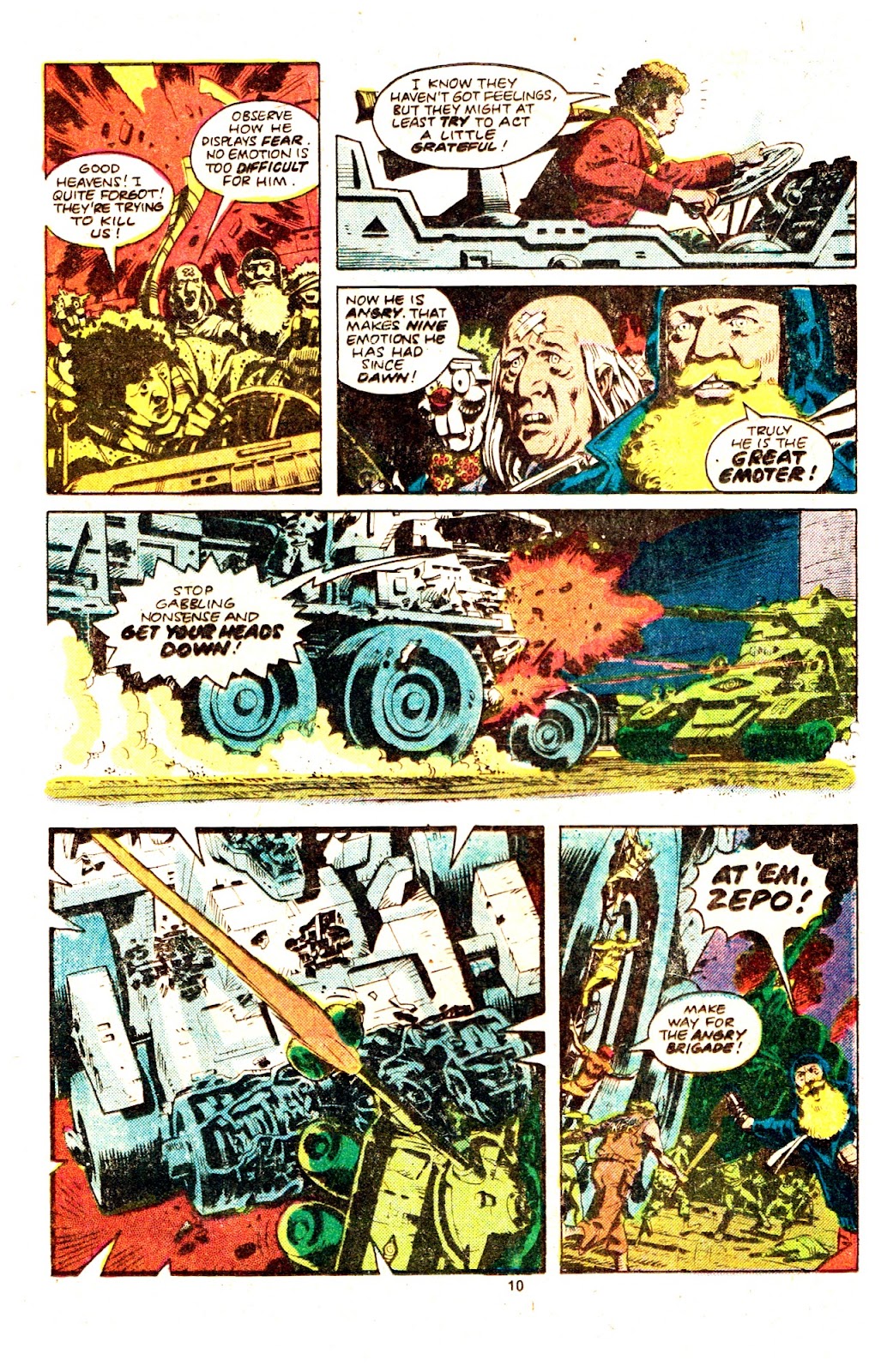 The bugs have infested the City, leaving a trail of skeletons for the Doctor to find. The Moderators observe them; but, cannot find the key to stopping the bugs. The Doctor realizes emotion will save the City and goes to appeal to the Brain trust, to spread emotion to save the City. They are skeptical, to say the least. 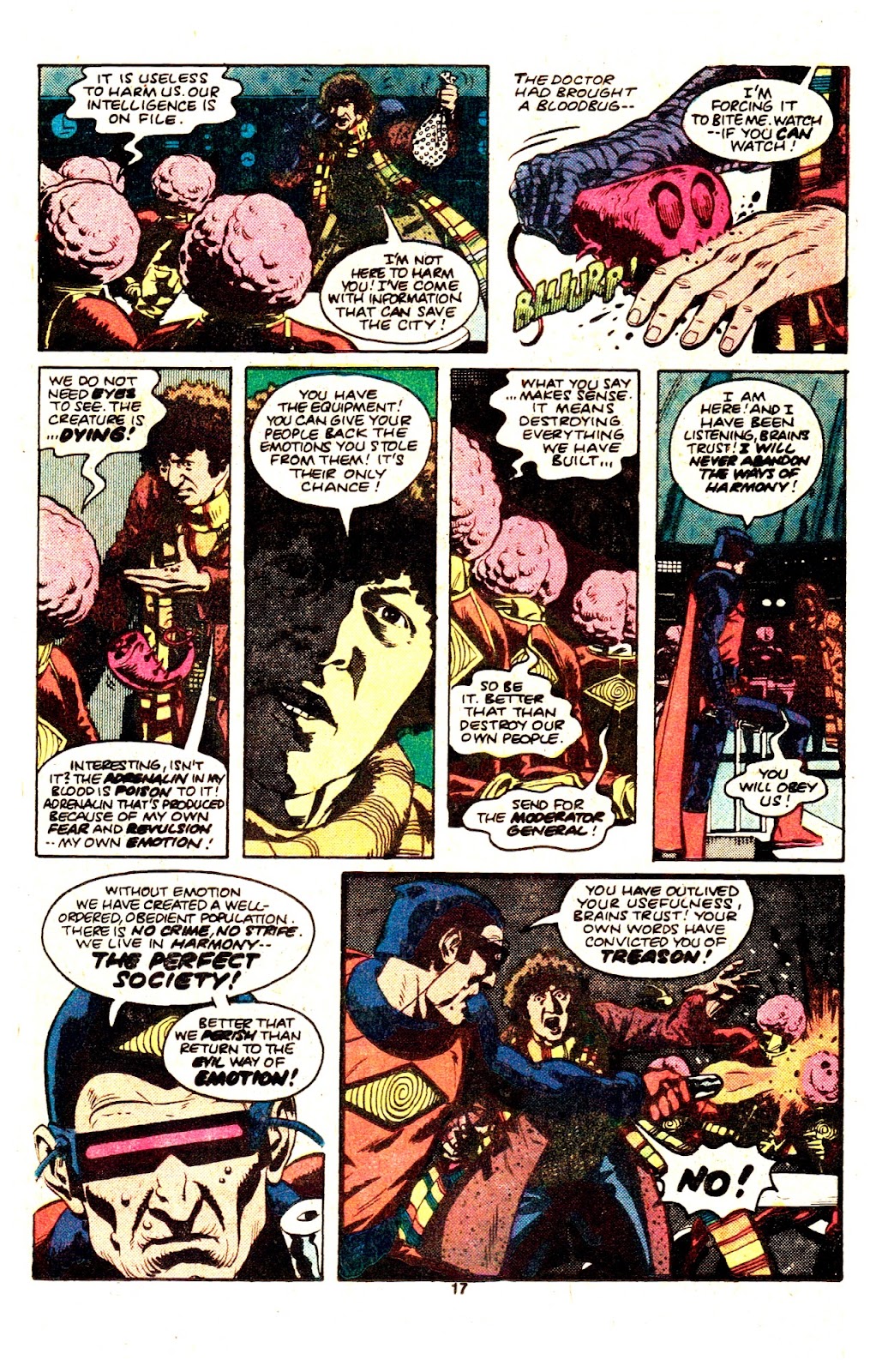 The Moderator General is against the idea. He kills the Brain Trust and the Doctor subdues him and ties him up in his scarf (it is pretty long). He then taps into the communication system and impersonates the Moderator General (by pinching his nose and speaking) and orders everyone to enter the Harmony Chambers. He then reverses the polarity of the neutron flow (oh, wait, that would be the Third Doctor) and the machines fill people with emotion, which poisons th attacking bugs, saving the city. The Doctor's work is done and he is about to leave, when ZEPO appeals for him to stay and teach them. he makes a compromise and leaves his E-waves, which has interesting results... 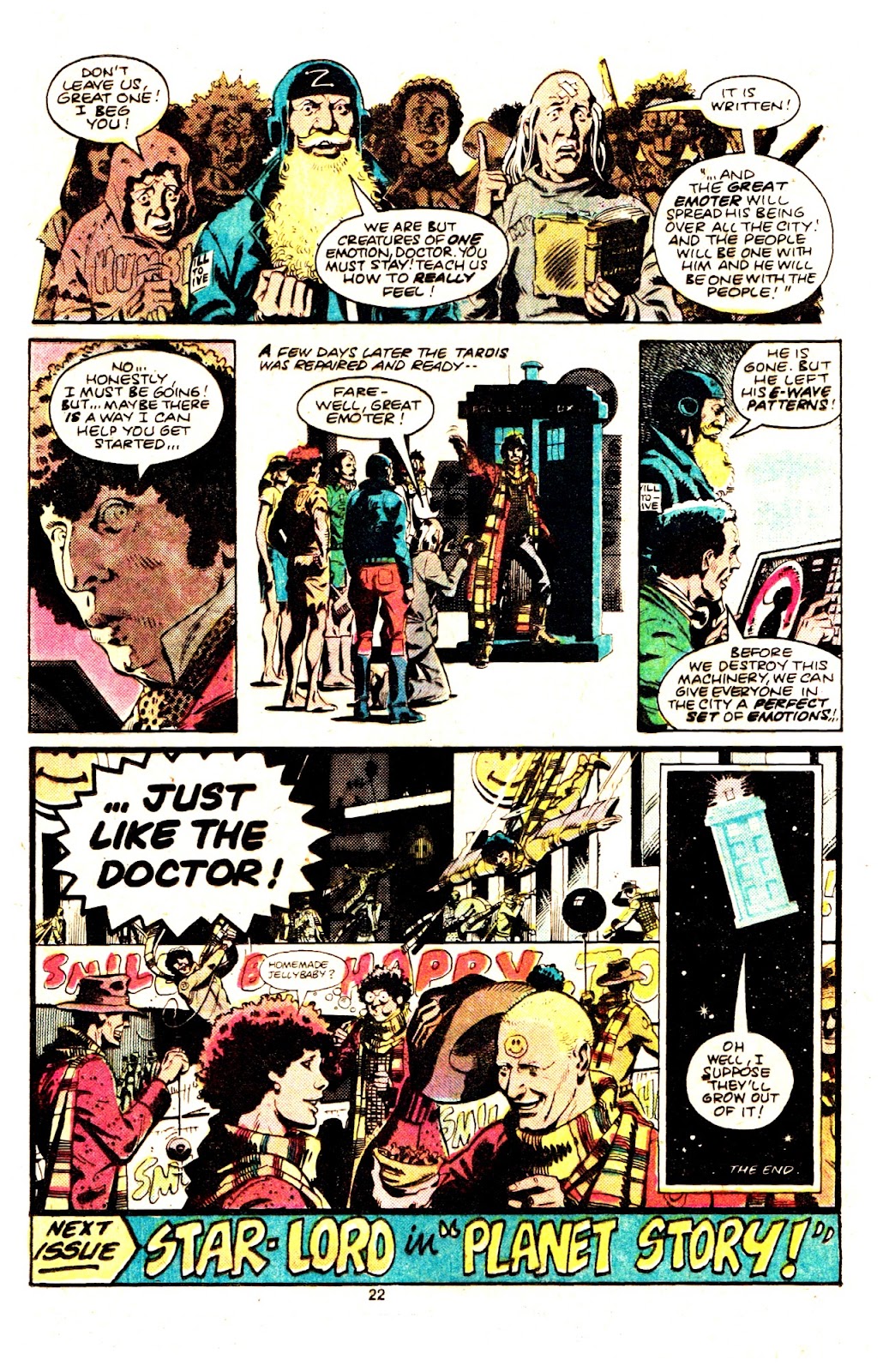 Issue 59's Werewolf story has a jack-knifed tractor/trailer, which has released rabid wolves, which were to be used for experiments. Jack Russell is stuck in traffic, trying to get home before nightfall; but, the truck prevents him from getting there and he turns into a werewolf and stops the rabid wolves, then gets attacked by cops (possibly John and Ponch). Woe is he. 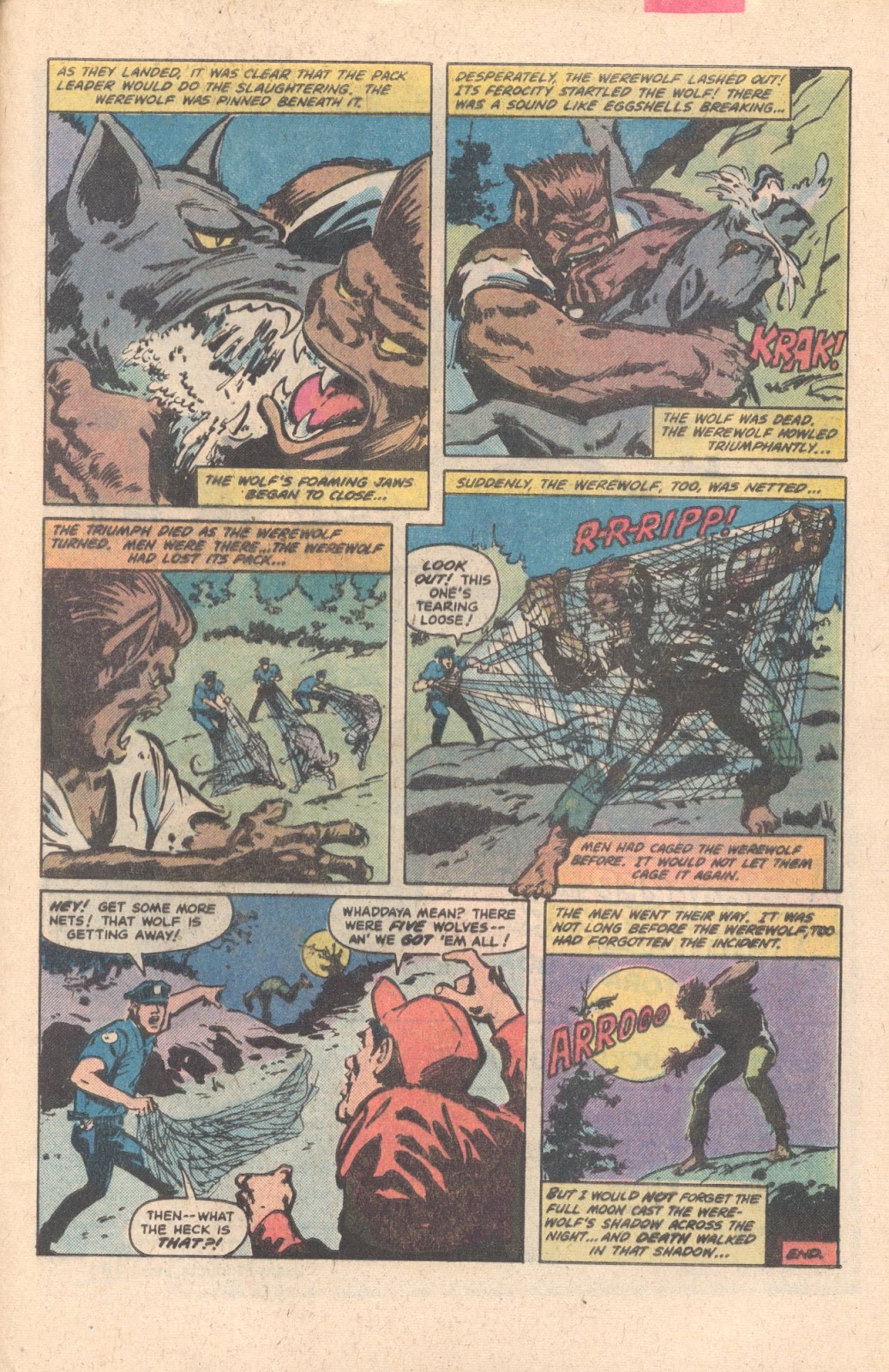 Issue 60 has a text feature, from Jo Duffy, about the 4th Doctor's run and the announcement of Peter Davison taking over as the 5th Doctor, with Janet Fielding as Tegan (left out Adric and Nyssa). Accompanying it are illustrations from Walt Simonson. now, I love Walt to death; but, he cannot draw a beret to save his life... 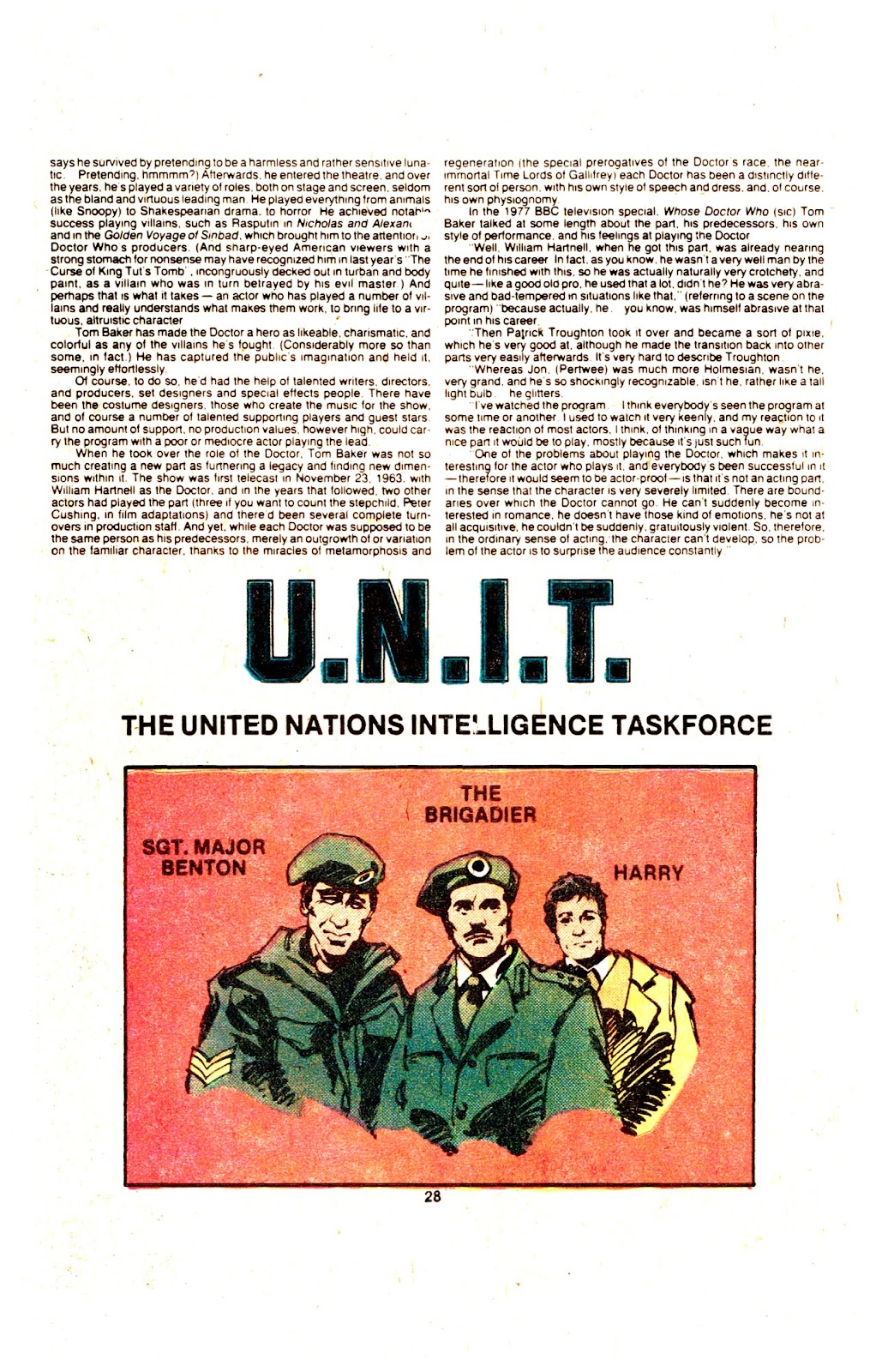 The Brigadier looks like he is wearing the official UNIT shower cap! Thoughts: Very fun story, which swipes from a variety of sources, including George Lucas' THX 1138, Orwell's 1984, Huxley's Brave New World, Bradbury's Fahrenheit 451, and Ellison's "Repent Harlequin!...Said the Tick-Tock Man." I don't think Wagner and Mills were trying to hide it, any more than the writers of the tv series hid their influences. Wagner and Mills have a talent for capturing Baker's voice and Gibbons captures his mannerisms. The only thing missing is a companion. None of these stories have featured the companions of the Doctor, from Sarah Jane Smith to Lela, Romana to Tegan, Nyssa & Adric. Just the Doctor. I don't know if that is an economic decision or an editorial. I could see them eschewing the companions to keep a more timeless quality to the stories; but, it robs the stories of one of the series dynamics. If using the tv companions was an issue, the solution would seem to be creating one for the comics. Anyone with knowledge in this regard, feel free to chime in. The Werewolf by Night story seems to serve little purpose, other than to fill space, and it is rather slight even for that. |
|
|
|
Post by codystarbuck on Jun 19, 2019 14:58:30 GMT -5
ps the letters page answers the cover question, as Paul Gulacy was supposed to do it; but, head a conflict with other work and Earl Norem stepped in to take care o it. The model is a little off, though not enough to really be glaring. The visor helps hide it.
|
|
|
|
Post by badwolf on Jun 19, 2019 15:09:28 GMT -5
You do have to remember that the issue of making characters look like the actors is a complicated one. Actors usually have control over the use of their likeness (the Star Wars cast signed away most of that, in use with the franchise) and in many cases the use of an exact likeness has not been authorized. So, the artist is stuck with trying to make it look close enough to the actor for audience identification; but, not so close as to get sued for unauthorized use. Well, I mean they all look like the actors to varying degrees. It's just that some artists have a more "cartoonish" style while others are more realistic. They all seem to be trying to draw the actors to the best of their abilities. It's not like Star Wars where they really didn't look like them at all (outside of the second and third movie adaptations). |
|
|
|
Post by beccabear67 on Jun 19, 2019 15:19:02 GMT -5
Dave Gibbons verged on a Wally Wood quality at times which I really liked. I had/have these as b&w Weekly/Monthly segments so never did get the colour versions (except a UK special that redid the Iron Legion story in colour on nice paper with this fancy new Gibbons cover).  ...and I do have the U.S. Star Lord one-shot though that used a single Gibbons Doctor Who story as a backup, the one with the butterfly people at the end. |
|
|
|
Post by codystarbuck on Jun 19, 2019 15:24:09 GMT -5
Marvel Premiere #61 Star Lord! Who? No, no, that was last issue. Creative Team: Doug Moench-writer, Tom Sutton-art, Tom Orzechowski-letters, Glynis Wein-colors, Jim Salicrup-edits Synopsis: Peter Quill and Ship are in orbit around a planet which should be able to sustain life. He sends down probes, which find evidence of buildings and other signs of intelligent life. Star Lord goes down to the planet and is attacked by the plant life... 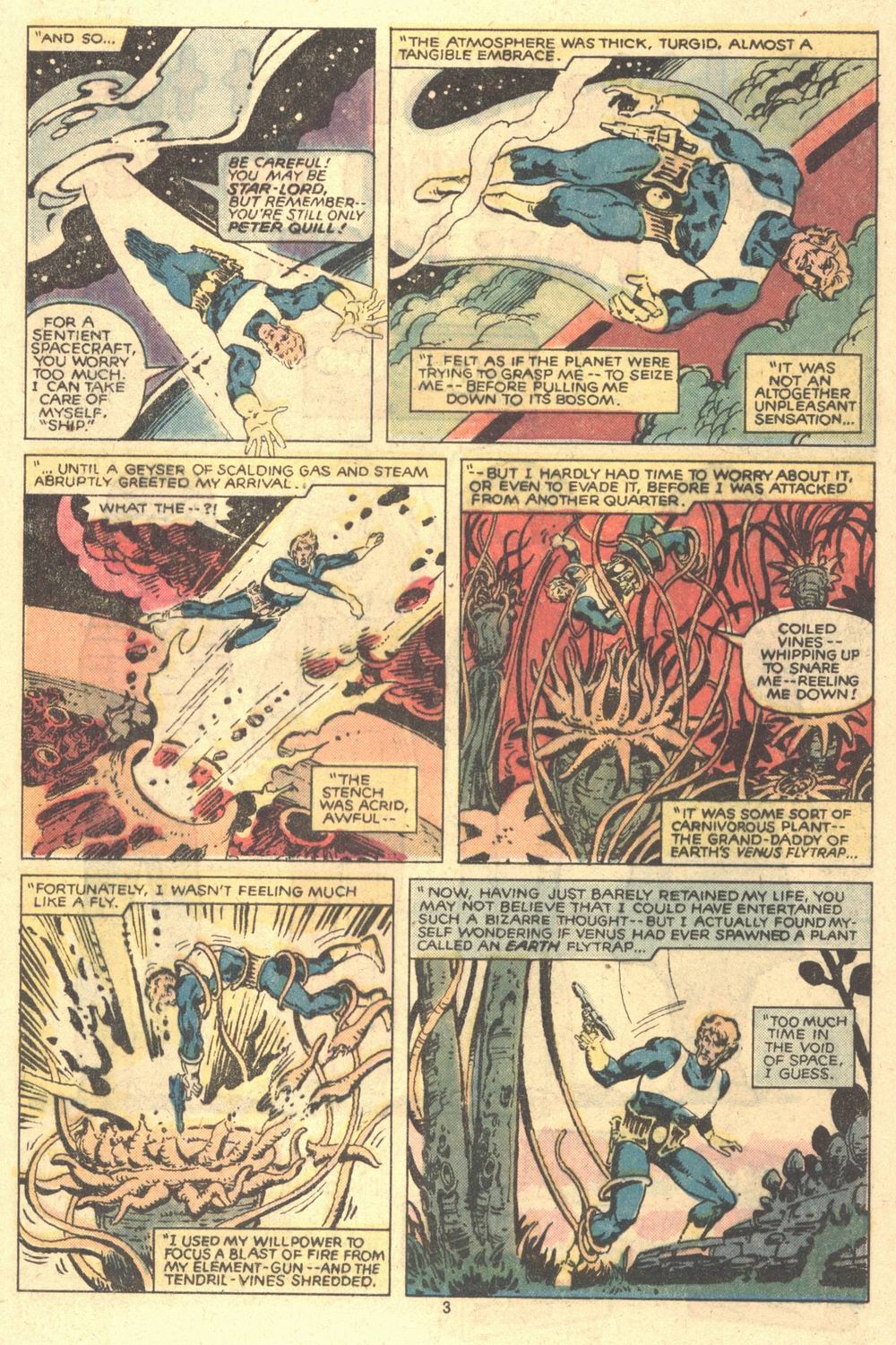 He escapes and heads for the city, when the ground erupts, spraying rock into the air, blocking him. He flies over t and lands in the city and is attacked by the elements and nearly crushed by falling rubble. he spots a cavern and enters it, where he finds cells which look like the chambers in a morgue... 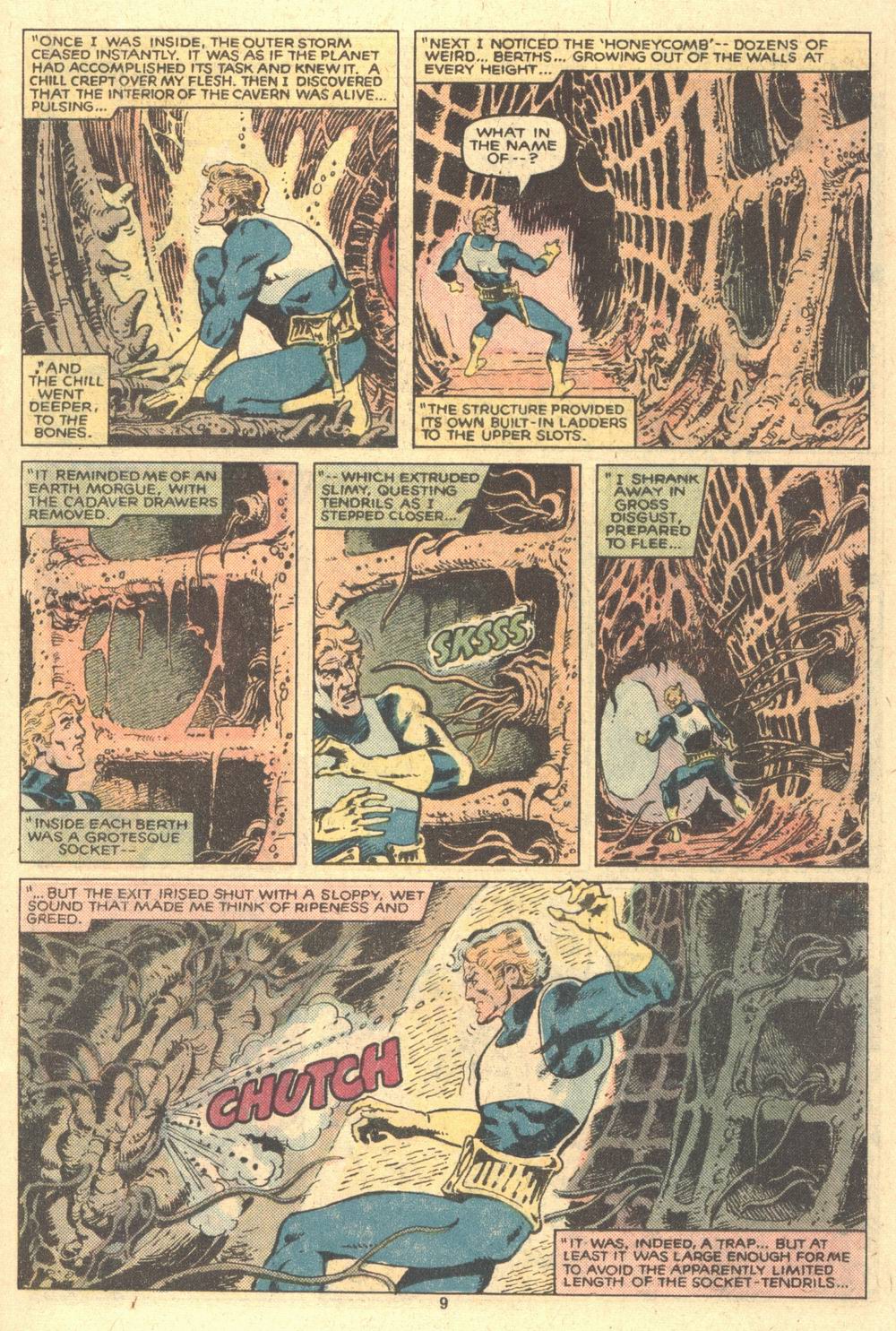 The chamber seals and then glowing worms and dust create images of the planet's history. It grew life, which evolved and built communities. the planet then harvested them for nutrients. the populace fought back and removed themselves to fortified cities and developed industrially. over time, it was killing the planet and resources became scarce. The civilization decayed. Finally, a small group of survivors went off world. The planet then started to recover.  The planet goes after Star Lord and captures him. What follows is a chapter of Ship processing the information and repeating the events of the first chapter. In Chapter 3, Quill awakens and blasts his way out, escaping to Ship. he then wants to destroy the planet and gets into a philosophical argument with Ship, over levels of life and right to exist. Ship wins out and they move on, oblivious to the planet's desire to be destroyed, due to loneliness. it is cursed to wait for another to make that decision. Thoughts: The structure of the story leads one to believe that it was intended for Marvel Preview, as it is more akin to that magazine's run of Star Lord stories. Chapter 2 is pretty much a rehash of chapter one, with a different viewpoint. The opening elements seem to be an homage to old sci-fi comics, like Planetary Comics and the EC sci-fi comics. Then, it gets rather existential as we see a symbiotic relationship between planet and lifeforms that grow upon it. When the balance is disrupted, both suffer. Obviously, an ecological metaphor for the polluting of our planet. Sutton is in his element with this kind of thing, with horrific images of life sucking plants and weird creatures, mixed with a space opera hero. It is much like Star Trek, in episodes like "The Devil in the Dark," with the Horta. Creepy, yet thoughtful stuff. Thus endeth Marvel Premiere. Apparently, Marvel no longer had a place for a try-out book. As it was, the mini-series was coming to the fore and it became the place to test a concept, or just a one-shot. Similarly, inventory stories could be used in mini-series or one-shots, or dumped on other titles. Marvel Premiere became the last survivor of the anthology wave that Marvel launched in the early-mid 70s.
|
|